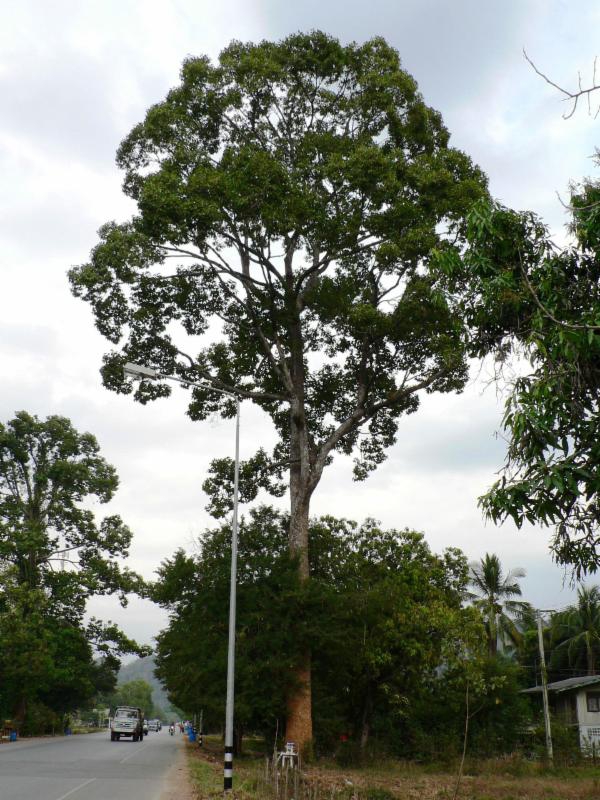| Citation |
|
Description |
Geographic Range [top]
Range Description: This tree is native to Sri Lanka, India (W Bengal, Andaman Islands), Bangladesh, Myanmar, Thailand, Lao PDR, Cambodia and southern Viet Nam. It possibly occurs in northern peninsular Malaysia. The species is found from 100 to 700 m asl and it has an estimated extent of occurrence (EOO) of over 2 million km2.
Countries occurrence:
Native:
Bangladesh; Cambodia; India (Andaman Is., West Bengal); Lao Peoples Democratic Republic; Myanmar; Sri Lanka; Thailand; Viet Nam
Additional data:
? Lower elevation limit (metres): 100
? Upper elevation limit (metres): 700
Range Map: Click here to open the map viewer and explore range.
Population [top]
Population: This species is widespread and is currently still fairly abundant. Trees within Viet Nam are confined to protected areas. The species has a generation length of 100 years. The population of this species has been reduced by more than 30% over the last three generations (300 years) and this decline is likely to continue in the next 100 years, especially in Cambodia.
Current Population Trend: Decreasing
Additional data:
Habitat and Ecology [top]
Habitat and Ecology: Dipterocarpus alatus is a large tree species growing to between 30 and 60 m in height (Singh et al. 2014). It is found within evergreen and semi-evergreen dipterocarp forests in low lying areas (foothills and valleys) (Singh et al. 2014). It is often found on ancient alluvial, granite and basalt rocks (Tam et al. 2014). The species requires well drained soil and humidity. It is tolerant to flooding but not to fire and the wind (Ecocrop 1993-2007). The species is insect pollinated, sets fruit between March and April and seed is wind dispersed (Tam et al. 2014). Its habitat is continuing to decline in area of occupancy (AOO), EOO and quality.
Systems: Terrestrial
Generation Length (years): 100
Use and Trade [top]
Use and Trade: This tree is used for timber. It belongs to the genus Dipterocarpus which produce commercially valuable medium hardwoods and have the trade name Keruing (Meier 2015). The wood is used for construction, plywoods and waterproofing baskets and boats. Tree resin can also be collected which is used to produce paint, varnish, lacquer (Tam et al. 2014) and for torches and caulking boats. The tree has medicinal properties; bark can be used to make a tonic to treat rheumatic complaints and the resin can be used to treat gonorrhoea (Singh et al. 2014). The species can be cultivated.
Threats [top]
Major Threat(s): The main threats for the species are deforestation for agriculture, commercial tapping of resin and exploitation for timber. Where selective logging occurs the species distribution is fragmented and low in density. The species is also at risk from loss of genetic diversity and genetic introgression as many specimens along the east coast of Peninsular Thailand are hybrids between D. alatus and D. chartaceus.
Conservation Actions [top]
Conservation Actions: The species is found in only eigth ex situ collections (BGCI 2017), more ex situ collections of this species should be made. The species occurs in protected areas and is widely cultivated in plantations. The species was previously globally assessed as Endangered (1998). Within Indonesia the species is only allowed to be harvested once it has reached 50 cm diameter at breast height (Masripatin et al. 2003). The majority of countries within its range have assessed the species to be a priority species for conservation (Luoma-aho et al. 2003). For example within Lao PDR the species has a conservation status of B which means the species is vulnerable due to restricted habitat, heavy human impact on the habitat and significant human use of the species (Phongoudome et al. 2003). The species is found in genetic conservation stands within Thailand (Sumantakui 2003). It is recommended that the habitat of the species be conserved and more information gathered on population size and decline. The species harvest and trade should be further monitored.
Citation: Ly, V., Nanthavong, K., Pooma, R., Barstow, M., Luu, H.T., Khou, E. & Newman, M. 2017. Dipterocarpus alatus. The IUCN Red List of Threatened Species 2017: e.T33007A2829912. Downloaded on 11 December 2017.
Disclaimer: To make use of this information, please check the .
Feedback: If you see any errors or have any questions or suggestions on what is shown on this page, please provide us with feedback so that we can correct or extend the information provided
|


